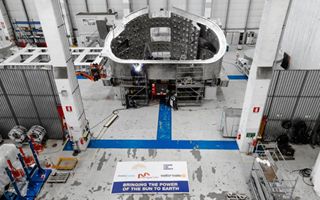(Finance) – Fusion for Energy (F4E), in collaboration with Ansaldo Nucleare, Westinghouse and Walter Tosto, has completed the production of the first European sector of the Vacuum Vessel for ITER, the largest international fusion experiment. In a ceremony held in Monfalcone, at the Westinghouse Industrial Plant, senior representatives from industry and politics gathered to celebrate the extraordinary technical achievement for the ITER project. The fabrication is based on ten years of work that directly involved more than 150 professionals and at least 15 companies from all over Europe with their respective workforces. F4E, which manages the European contribution to ITER, amounting to almost half of the project, has successfully created, together with its industrial partners, a unique supply chain, supported by expertise and capacity to produce complex components for future fusion reactors.
“The first European sector – he commented Marc Lachaise, Director of Fusion for Energy – is the result of the partnership between F4E, the Ansaldo Nucleare consortium, Westinghouse (Mangiarotti), Walter Tosto and the ITER Organization. Our commitment to deliver results, teamwork and innovative thinking have been the driving forces behind this remarkable achievement. A testament to the European engineering know-how we can be proud of and proof of our determination to exploit the potential of fusion energy. ITER has also helped to strengthen Europe’s competitiveness and raise the bar in manufacturing.”
“The production of the first European sector of the Vacuum Vessel for ITER, realized by the AMW Consortium, demonstrates the excellent collaboration between the Consortium, the customer F4E and the ITER Organization – stated Daniela Gentile, CEO of Ansaldo Nucleare –. We are proud of the dedication and hard work of the Ansaldo Nucleare team over the years, as the completion of this sector marks a significant milestone not only for the ITER project but also for the future of fusion energy, demonstrating the capabilities of the Italian nuclear value chain”.
“Westinghouse and the many professionals at our Monfalcone facility have been working for years on this manufacturing milestone for the ITER project,” said Dan Sumner, president of Westinghouse Operating Plant Services –. We are proud that the collaboration with our valued partners Ansaldo Nucleare and Walter Tosto, under the leadership of F4E, has allowed all of us to realize this shipment of key components for the continued development of clean and reliable energy for what is truly an unprecedented global cooperation”.
“Today is an extraordinary day. This milestone is the result of the fundamental contribution of many people who, with dedication and passion, have made possible what we are celebrating today,” he said. Luca Tosto, CEO of Walter Tosto –. It has been a journey full of technological challenges, which we have faced and overcome successfully, coming out stronger and more valued. Now we are ready and we look with confidence to future challenges”.
The Vacuum Vessel can be described as a massive double-walled container that will house the fusion reaction. It will provide a clean environment that will prevent dust, air, liquids and impurities from entering its chamber. Thanks to a series of powerful superconducting magnets that will hug the container, the plasma will float without touching its walls. The ITER Vacuum Vessel is composed of nine sectors. Europe will provide five and the Republic of Korea the remaining four. The component has a diameter of 19.4 m, a height of 11.4 m and a weight of about 5,200 tonnes. It complies with the strict standards set by the French Nuclear Safety Authority to operate safely.
It is worth remembering that its shape and size present a number of challenges. Each sector has approximately 150 km of weld seams. At all production sites, large teams of technicians, metrology experts, engineers and quality assurance managers continuously inspected production to reduce risks. More than 20,000 hours of work and at least 100,000 hours of welding were required to produce the first European sector. Two of the segments (1 and 4) were produced at the Westinghouse site in Monfalcone, while the other two (2 and 3) were produced at the Walter Tosto site in Chieti. The segments were assembled and then welded. The sector is leaving Italy in September and will be shipped to Fos-sur-Mer, the industrial port of Marseille. It will then be loaded onto a huge trailer and transported to the ITER site. The other four European sectors are in production and will be delivered over the next two years.
